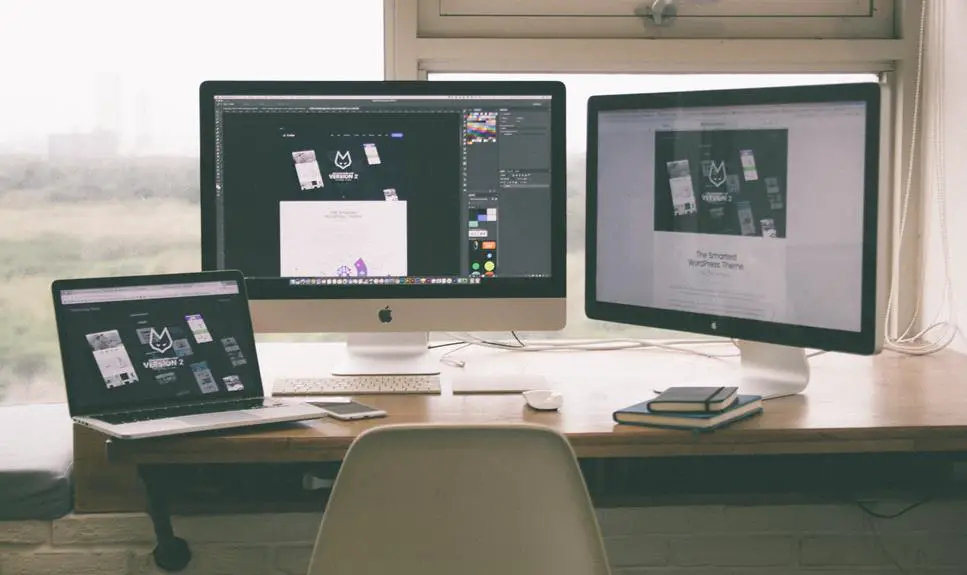Looking to elevate your home office game? Are stacking curved monitors the ultimate home office setup?
Discover the benefits of creating a panoramic view, maximizing screen real estate, and enhancing multitasking capabilities. With a focus on productivity and ergonomics, optimizing your workflow and staying ahead of future trends is key.
Let's delve into the considerations before stacking monitors, setting up a stacked monitor display, and how this setup can revolutionize your work-from-home experience.
Key Takeaways
- Stacking curved monitors provides an expanded field of view, increased screen real estate, and enhances multitasking capabilities.
- The ergonomic considerations of stacking curved monitors include maintaining ergonomic viewing angles, monitor height at or below eye level, and reducing neck strain and eye strain.
- Cable management solutions are important for a neat and organized workspace when stacking curved monitors, including using cable trays, raceways, or sleeves for concealment.
- Compatibility and mounting considerations include ensuring VESA compliance for secure attachment, selecting monitor stands compatible with curved monitors, and verifying weight restrictions for stability.
Benefits of Stacking Curved Monitors
You can enjoy an expanded field of view and enhanced multitasking capabilities with two curved monitors stacked in your home office setup. The improved productivity that comes with having a wider and more immersive display is unparalleled.
By stacking curved monitors, you create a seamless and panoramic view that allows you to easily switch between different tasks without the need to constantly minimize and maximize windows. This enhanced immersion can lead to a more focused and efficient workflow, as you can keep multiple applications and documents open and visible at the same time.
The increased screen real estate also means you can have more information in front of you at once, reducing the need for constant tab-switching and minimizing distractions. This setup promotes a more organized and streamlined work environment, ultimately leading to improved productivity.
The curvature of the monitors further adds to the immersive experience, wrapping your visual field and drawing you into your work. With the ability to see more at a glance and seamlessly navigate between tasks, stacking curved monitors can significantly enhance your overall productivity and efficiency in the home office.
Considerations Before Stacking Monitors
Before stacking monitors, it's important to consider ergonomic viewing angles to prevent neck strain.
You should also think about cable management solutions to keep your workspace tidy and organized.
Additionally, ensure that your monitors are compatible with VESA mounting to facilitate easy installation.
Ergonomic Viewing Angles
Consider the ergonomics of viewing angles before stacking curved monitors for your home office setup. To ensure a comfortable and productive work environment, pay attention to the following:
- Monitor Height: Position the top of the monitor at or slightly below eye level to reduce neck strain.
- Tilt and Swivel: Opt for monitors with adjustable stands to tilt and swivel, allowing for customizable viewing angles.
- Distance: Maintain an arm's length distance between your eyes and the screen to minimize eye strain.
- Curvature Alignment: When stacking curved monitors, ensure that the curvature aligns seamlessly to create a natural and immersive viewing experience.
Cable Management Solutions
When considering stacking curved monitors, it's essential to prioritize cable management solutions for seamless integration and a clutter-free workspace. Cable organization is crucial for maintaining workspace aesthetics and ensuring a professional, organized environment.
To achieve this, consider investing in cable concealment options such as cable trays, raceways, or sleeves to keep wires neatly tucked away and out of sight.
Additionally, desk organization plays a significant role in managing cables effectively. Opt for desks with built-in cable management features or utilize cable clips and ties to keep wires organized and prevent them from tangling.
Compatibility With VESA
To ensure seamless integration when stacking curved monitors, prioritize considering the compatibility with VESA standards for mounting options. When evaluating VESA compatibility, focus on the following key considerations:
- VESA Compatibility: Ensure that the monitors and the monitor stands are VESA compliant to guarantee that they can be securely attached to each other.
- Monitor Stands: Select monitor stands that are designed to support curved monitors and are compatible with VESA mounting standards.
- Screen Size: Check the VESA compatibility of the monitor stands to ensure they can accommodate the screen size of the curved monitors being stacked.
- Weight Restrictions: Verify that the monitor stands can handle the combined weight of the stacked curved monitors to avoid any structural or stability issues.
Consider these factors to ensure that the monitor stacking setup isn't only visually appealing but also safe and functional.
Setting Up a Stacked Monitor Display
When setting up a stacked monitor display, it's important to consider how you'll mount and position the monitors for optimal viewing.
Make sure to explore cable management tips to keep your setup organized and free of clutter.
Mounting and Positioning Monitors
To achieve an optimal stacked monitor display, position the monitors using adjustable mounts for precise alignment and comfortable viewing. When setting up your stacked monitor display, consider the following:
- Mounting Options: Choose VESA-compatible mounts to securely stack your curved monitors, ensuring stability and flexibility in positioning.
- Monitor Alignment: Ensure the top monitor is directly above the bottom one, reducing neck strain and creating a seamless viewing experience.
- Ergonomic Positioning: Adjust the height and tilt of each monitor to maintain a natural posture, minimizing discomfort during extended use.
- Cable Management: Organize and conceal cables to maintain a tidy workspace and prevent any interference with the stacked monitor setup.
Cable Management Tips
Positioning and concealing cables is crucial for maintaining a tidy workspace and preventing interference with the stacked monitor setup.
Start by organizing cables using zip ties or cable sleeves to prevent tangling and ensure a clean look.
Utilize cable clips or adhesive cable organizers to secure cables to the back of the monitors and desk, keeping them out of sight and maintaining workspace aesthetics.
Consider using a cable management tray or box to conceal power strips and adapters, further enhancing cord concealment and desk organization.
Opt for longer cables to allow for better cable routing and to avoid tension or strain on connected devices.
Productivity and Ergonomics With Stacked Monitors
With stacked monitors, you can improve your productivity and ergonomics in the home office.
Here are four ways stacking curved monitors can enhance your home office setup:
- Health Benefits: Stacking monitors allows for better posture and reduced strain on your neck and shoulders. By positioning your primary monitor at eye level and angling the secondary monitor slightly downward, you can minimize discomfort and potential long-term health issues associated with poor ergonomics.
- Increased Productivity: Utilizing stacked monitors can enhance multitasking capabilities, enabling you to work on multiple projects simultaneously without the need to constantly switch between tabs or windows. This setup can lead to better focus and efficient task management, ultimately boosting your overall productivity.
- Optimized Workspace Aesthetics: Stacking monitors creates a sleek and organized look, minimizing clutter and maximizing desk space. This setup contributes to a visually appealing and professional home office environment, which can positively impact your mindset and work performance.
- Cost Effectiveness: Rather than investing in a larger single monitor, stacking two smaller monitors can be a cost-effective solution for expanding screen real estate, offering comparable benefits without the hefty price tag. This approach allows you to achieve a dual-monitor setup without breaking the bank.
Optimizing Workflow With Stacked Curved Monitors
By organizing your workspace with stacked curved monitors, you can streamline your workflow and boost productivity. Workspace organization plays a crucial role in maximizing efficiency.
With stacked monitors, you can arrange your screens to suit your specific tasks, whether it's coding, graphic design, or data analysis. Monitor placement is key to optimizing workflow, as you can have reference materials on one screen while working on another.
This setup provides an expansive screen real estate, allowing you to view multiple documents or applications simultaneously without the need to constantly switch between tabs or windows. The seamless transition across screens minimizes distractions and enhances focus, ultimately leading to productivity benefits.
Additionally, the curved design of the monitors immerses you in your work, reducing eye strain and creating a more comfortable viewing experience.
Future Trends in Home Office Monitor Setups
To stay ahead of the curve in optimizing your home office setup, consider the future trends shaping monitor configurations for enhanced productivity and comfort.
- Monitor evolution: Keep an eye on advancements in monitor technology, such as higher resolutions, faster refresh rates, and improved color accuracy. These developments will enhance visual clarity and reduce eye strain, leading to a more comfortable and productive work experience.
- Workspace trends: Look out for innovative workspace designs that integrate monitors seamlessly into the environment, such as adjustable monitor arms, built-in cable management, and ergonomic mounting solutions. These trends will contribute to a more organized and visually appealing home office setup.
- Enhanced connectivity: Anticipate the integration of wireless technologies and seamless multi-device connectivity, allowing for effortless transitions between different devices and screen configurations. This will enable a more flexible and convenient workflow, boosting overall efficiency.
- Customizable configurations: Expect the rise of modular monitor setups that allow users to create personalized configurations tailored to their specific workflow needs. This trend will offer greater flexibility and adaptability in designing the ideal home office monitor setup.
Frequently Asked Questions
Can Stacking Curved Monitors Cause Any Damage to the Monitors or Affect Their Longevity?
Stacking curved monitors can potentially cause damage over time due to increased pressure on the bottom monitor. To avoid this, ensure proper support and regular maintenance to prevent any negative impact on their longevity.
Are There Any Specific Requirements for the Desk or Mounting System When Setting up a Stacked Monitor Display?
When setting up a stacked monitor display, consider the desk requirements and mounting system limitations. Ensure the desk can support the weight and size of the monitors, and choose a mounting system that can accommodate curved monitors.
How Does the Use of Stacked Curved Monitors Impact Energy Consumption and Environmental Sustainability?
Using stacked curved monitors can impact energy efficiency and environmental sustainability. The increased power usage and production of multiple monitors can lead to higher energy consumption and a larger environmental footprint, so consider these factors when setting up your home office.
Are There Any Potential Drawbacks to Using Stacked Curved Monitors for Certain Types of Work or Activities?
When using stacked curved monitors, potential limitations may arise, affecting productivity and comfort. Ergonomic concerns, like neck strain and eye fatigue, could impact certain work or activities. It's essential to consider these factors for an optimal setup.
What Are the Potential Challenges or Limitations When It Comes to Integrating Additional Technology or Accessories With a Stacked Monitor Setup?
Integrating additional technology with stacked monitors can pose challenges. Compatibility issues may arise, impacting seamless integration. Understanding these limitations is crucial for mastering a stacked monitor setup in your home office.




